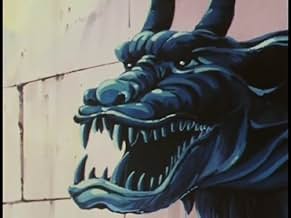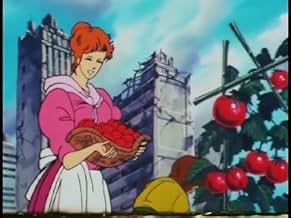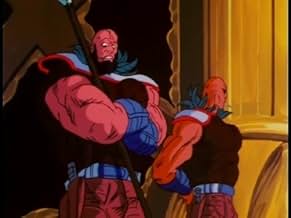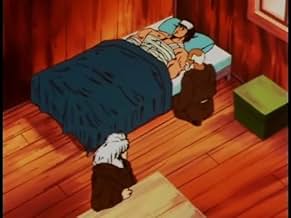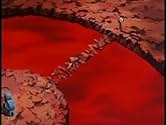After a nuclear war turns Earth into a lawless wasteland, Kenshiro, a practitioner of the deadly master art "Hokuto Shinken", fights a succession of tyrannical warriors to restore order.After a nuclear war turns Earth into a lawless wasteland, Kenshiro, a practitioner of the deadly master art "Hokuto Shinken", fights a succession of tyrannical warriors to restore order.After a nuclear war turns Earth into a lawless wasteland, Kenshiro, a practitioner of the deadly master art "Hokuto Shinken", fights a succession of tyrannical warriors to restore order.
Browse episodes
Featured reviews
Wow....just finished the 109 episodes ; this story in not only amazing by its dept and maturity make it one of the best manga that I ever seen.
I recommand that you look at this serie before anything else of the Hokuto.
I recommand that you look at this serie before anything else of the Hokuto.
"Hokuto no Ken" ("Fist of the North Star," 1984) took its cue from the Australian movies, MAD MAX (1979) and THE ROAD WARRIOR (aka MAD MAX 2, 1981), and pioneered a new style of violent animated action on Japanese television. It presented a more exaggerated version of the movies' post-apocalyptic landscape and its roving bands of savage bikers with Mohawk haircuts, spiked leather and bulging muscles who ravage the budding communities trying to rebuild society in a bleak and devastated terrain. Into the role of defender of the weak steps Ken, master of Hoto Shin Ken, or Fist of the North star, an intricate martial arts system that wreaks havoc on his opponents' nervous systems and causes all kinds of fatal disfigurements, usually an exploding decapitation. The stoic, deadpan Ken brooks no argument with those who offend him and spends most of the series ridding the landscape of these musclebound cretins. To balance out the constant violence with regular doses of sentiment, Ken's empathetic qualities are drawn out by the presence of two children, an adolescent harmonica-playing boy and a young girl saddled with a puppy, who become Ken's companions for much of the series.
While the violence is quite gruesome, the gore is muted by depicting the exploding heads in silhouette or shadow and having the spurting body fluids colored neutral hues. The carnage is, nevertheless, particularly satisfying because we get to watch dozens of murderous thugs get wasted, one by one, in colorful and imaginative ways. (The 1986 animated feature version of this series, also called FIST OF THE NORTH STAR, was much more explicit in its bloodshed.)
The first series lasted for 109 episodes, from 1984 to 1987, while a second series (1987-88) lasted 43 episodes. A number of episodes from the first season have been released in the U.S. and include the first story arc (22 episodes), which involves Ken's quest for vengeance against Shin, his one-time buddy and master of the Fist of the Southern Cross, who took Ken's girl away from him--by force--and left him with a seven-mark scar in the form of Ursa Major, the Big Dipper (or Great Bear) constellation. The second story arc gave Ken a new and equally formidable opponent in Raoh, master of Nanto Suichoken, a technique which literally slices opponents into pieces.
The animation does an expert job of recreating the stark imagery of the original manga (comic book), which was written by "Buronson" and drawn by Tetsuo Hara, capturing the near-desert landscape and spectacular urban ruins in evocative detail. The character design is equally well-etched, with great linework applied to even the most transient characters. Color is used well in both the parched quality of the arid landscape and the flamboyant nature of the rampaging biker gangs with their clown makeup and playing card gang motifs. There's a wash quality, suggesting water colors, in some of the background art. It should be pointed out that the hard-edged look and tone of the series is something traditional pen-and-ink animation could do so well but is much harder to achieve in the overly slick digital animation era in which anime finds itself today. A series like FIST is more to be valued because of the near impossibility of duplicating such an effort today.
While the violence is quite gruesome, the gore is muted by depicting the exploding heads in silhouette or shadow and having the spurting body fluids colored neutral hues. The carnage is, nevertheless, particularly satisfying because we get to watch dozens of murderous thugs get wasted, one by one, in colorful and imaginative ways. (The 1986 animated feature version of this series, also called FIST OF THE NORTH STAR, was much more explicit in its bloodshed.)
The first series lasted for 109 episodes, from 1984 to 1987, while a second series (1987-88) lasted 43 episodes. A number of episodes from the first season have been released in the U.S. and include the first story arc (22 episodes), which involves Ken's quest for vengeance against Shin, his one-time buddy and master of the Fist of the Southern Cross, who took Ken's girl away from him--by force--and left him with a seven-mark scar in the form of Ursa Major, the Big Dipper (or Great Bear) constellation. The second story arc gave Ken a new and equally formidable opponent in Raoh, master of Nanto Suichoken, a technique which literally slices opponents into pieces.
The animation does an expert job of recreating the stark imagery of the original manga (comic book), which was written by "Buronson" and drawn by Tetsuo Hara, capturing the near-desert landscape and spectacular urban ruins in evocative detail. The character design is equally well-etched, with great linework applied to even the most transient characters. Color is used well in both the parched quality of the arid landscape and the flamboyant nature of the rampaging biker gangs with their clown makeup and playing card gang motifs. There's a wash quality, suggesting water colors, in some of the background art. It should be pointed out that the hard-edged look and tone of the series is something traditional pen-and-ink animation could do so well but is much harder to achieve in the overly slick digital animation era in which anime finds itself today. A series like FIST is more to be valued because of the near impossibility of duplicating such an effort today.
For me Fist of the North Star will and always be the "BEST" that Manga's ever produced.
Violence and humor were here. I'm amazed to just realize that this was made in 1984 as I first viewed this back in 1993 assuming it that it came out then?
Brilliant artwork excellent voice-over characterization really help give this film a convincing approach as to how well you immerse yourself with both plot and character details.
Don't let this one pass you by, Fist of the North Star rules. . ..
Violence and humor were here. I'm amazed to just realize that this was made in 1984 as I first viewed this back in 1993 assuming it that it came out then?
Brilliant artwork excellent voice-over characterization really help give this film a convincing approach as to how well you immerse yourself with both plot and character details.
Don't let this one pass you by, Fist of the North Star rules. . ..
This series itself retains something of a cult following - not least because of its distinctive tone and setting, which packages pounding martial arts action, a deconstruction of the family, as well as interesting homo-erotic undertones - all set in a Mad Max style post-catastrophe landscape. After a devastating global war, we are told, life for mankind has turned into a nightmarish struggle, not only because of the barren environment but through the depredations of mentally deranged, mutated savages.
Ranged against them, and all evildoers, is Kenshiro, master of a particular fighting technique, Hokuto Shinken, a virtually unbeatable martial skill that works on manipulating the secret power points of opponent's bodies, destroying them from within. Ken was trained up with his evil half-brother Shin, the Fist of the South Star, and who represents a polar opposite from him. He practices Nanto Seiken, a martial art that destroys from without. But Shin stole Ken's beloved Julia, this after fighting our hero, marking his chest with the seven distinctive scars which echo the sign of the Big Dipper and leaving him for dead. The narrative of Fist Of The North Star primarily consists of Ken's attempts to regain Julia and overcoming various champions of Shin.
The series makes almost no concessions to reality - not least of which are the sheer number of Shin's followers, duly met and thrashed on each occasion by Ken (or come to that, the amount of thin T-shirts which the hero destroys, then replaces unseen, with each encounter). His opponents are generally the mutants, who as a group are unsympathetic, grotesque and brutish. Many viewers have commented on the surreal arrogance of these killers, their bodies often drawn ridiculously out of proportion, towering over hero Ken and the regular humans. But mutation is just as it suggests, although the animators feel free to add to the macho incongruity of it all by adding Mohican haircuts, outrageous outfits and snarling dialogue. In comparison Ken is a model of sobriety, often warning his opponents to cease their activities before he strikes.
On his travels Ken is accompanied by two youthful helpers, both acquired in the first few episodes. One is the orphan girl Lynn and her puppy. The other is Bart, Ken's self styled 'business manager' as he makes clear in an earlier episode always, ostensibly on the fighters behalf, always looking for the main chance to profit from Ken's unique skills. Together with a repeated emphasis on Ken's lost love Julia, this group makes up a peculiarly fractured family, with normal relationships distorted by the world in which they find themselves. From this point of view, Ken's repeated attempts to get his woman back, as well as his repeated rescuing of social groupings (the mutants never have kin), equates a drive for regular familial balance.
The twist is North Star's visual insistence at the same time on butch body display and the repeated physical contact between the vaguely camp males making up the greatest number of dominant characters each week. (My favourite is the handlebar-moustached and splendidly named Colonel Mad, who fights with his blades dipped in scorpion venom.) In fact Ken faces no villainesses at all, at least until well into the second DVD volume. This is a series where the exaggerated torsos of the combatants is a hallmark, only equalled by their swollen braggadocio, itself suggestive of sexual taunting. Blood in the show is never the common red; rather it assumes a weird milky colour, exploding into the air at the climax of each encounter, while Ken's characteristic chest scarring was symbolically produced by the slow penetration of his skin by Shin's powerful fingers - a moment echoed later in the series. The result of all this imagery is thematic psychosis, arguably as pronounced as that enjoyed by the mutants who populate the landscape of future Earth: heterosexual Ken has a lady love and two children in tow; 'other' Ken with his body builder physique, has an intense relationship with his half brother, wears tight T-shirts and sleeveless jackets, and spills all that uniquely coloured blood in one casual encounter after another...
The distinctive 1980s' animation style is an advantage when depicting such a barren landscape, the desolation of which also reflecting Ken's emotional emptiness, deprived of Julia's presumed humanising contact. Manga's box set offers generally excellent picture quality. Opinion has been divided over the relative merits of the two soundtracks on offer; the original Japanese suffers from its mono origins while the re-release English dub offers a more visceral techno musical score, which more easily conveys the urgent brutality of it all. However this reviewer, at least, prefers the original with its far more sympathetic voicing of Ken's young followers - his modern voice in particular makes of Bart an irritating brat - while the score, although less monolithic, has a contemporary charm. Most especially, each episode is interrupted for an on-screen announcement of the baroque martial technique Ken has selected for the current fight ('Spinning Wheel Explosive Punch', 'The Hundred Crack Fist', 'Mountain Splitting Wave', etc). The modern version does its best, but the original intonation makes such moments highlights in themselves.
Fist Of The North Star is full of such ritualistic moments: the repeated (and failed) attempts of Shin to woe Julia for instance, or the rending of Ken's red shirt; the various exploding heads, or the fighter's famous pronouncement over those opponents whom, it appears, he has just touched, and who continue their arrogance yet: "You are already dead." In addition, each of the episodes is named in vengeful, declamatory fashion: Villains! Ready Your One Way Ticket To Hell!; Stormy Times, Titanic Battles, Is Battle All That Awaits Me?; Sinners! Thy Name Is Fang! etc. It's a characteristic that seems bizarre to western eyes, but the self-awareness reveals something about the original, local deliberation behind the series. Seen today, despite - or because of - its extremes, and curious undertones, it remains strangely addictive.
Ranged against them, and all evildoers, is Kenshiro, master of a particular fighting technique, Hokuto Shinken, a virtually unbeatable martial skill that works on manipulating the secret power points of opponent's bodies, destroying them from within. Ken was trained up with his evil half-brother Shin, the Fist of the South Star, and who represents a polar opposite from him. He practices Nanto Seiken, a martial art that destroys from without. But Shin stole Ken's beloved Julia, this after fighting our hero, marking his chest with the seven distinctive scars which echo the sign of the Big Dipper and leaving him for dead. The narrative of Fist Of The North Star primarily consists of Ken's attempts to regain Julia and overcoming various champions of Shin.
The series makes almost no concessions to reality - not least of which are the sheer number of Shin's followers, duly met and thrashed on each occasion by Ken (or come to that, the amount of thin T-shirts which the hero destroys, then replaces unseen, with each encounter). His opponents are generally the mutants, who as a group are unsympathetic, grotesque and brutish. Many viewers have commented on the surreal arrogance of these killers, their bodies often drawn ridiculously out of proportion, towering over hero Ken and the regular humans. But mutation is just as it suggests, although the animators feel free to add to the macho incongruity of it all by adding Mohican haircuts, outrageous outfits and snarling dialogue. In comparison Ken is a model of sobriety, often warning his opponents to cease their activities before he strikes.
On his travels Ken is accompanied by two youthful helpers, both acquired in the first few episodes. One is the orphan girl Lynn and her puppy. The other is Bart, Ken's self styled 'business manager' as he makes clear in an earlier episode always, ostensibly on the fighters behalf, always looking for the main chance to profit from Ken's unique skills. Together with a repeated emphasis on Ken's lost love Julia, this group makes up a peculiarly fractured family, with normal relationships distorted by the world in which they find themselves. From this point of view, Ken's repeated attempts to get his woman back, as well as his repeated rescuing of social groupings (the mutants never have kin), equates a drive for regular familial balance.
The twist is North Star's visual insistence at the same time on butch body display and the repeated physical contact between the vaguely camp males making up the greatest number of dominant characters each week. (My favourite is the handlebar-moustached and splendidly named Colonel Mad, who fights with his blades dipped in scorpion venom.) In fact Ken faces no villainesses at all, at least until well into the second DVD volume. This is a series where the exaggerated torsos of the combatants is a hallmark, only equalled by their swollen braggadocio, itself suggestive of sexual taunting. Blood in the show is never the common red; rather it assumes a weird milky colour, exploding into the air at the climax of each encounter, while Ken's characteristic chest scarring was symbolically produced by the slow penetration of his skin by Shin's powerful fingers - a moment echoed later in the series. The result of all this imagery is thematic psychosis, arguably as pronounced as that enjoyed by the mutants who populate the landscape of future Earth: heterosexual Ken has a lady love and two children in tow; 'other' Ken with his body builder physique, has an intense relationship with his half brother, wears tight T-shirts and sleeveless jackets, and spills all that uniquely coloured blood in one casual encounter after another...
The distinctive 1980s' animation style is an advantage when depicting such a barren landscape, the desolation of which also reflecting Ken's emotional emptiness, deprived of Julia's presumed humanising contact. Manga's box set offers generally excellent picture quality. Opinion has been divided over the relative merits of the two soundtracks on offer; the original Japanese suffers from its mono origins while the re-release English dub offers a more visceral techno musical score, which more easily conveys the urgent brutality of it all. However this reviewer, at least, prefers the original with its far more sympathetic voicing of Ken's young followers - his modern voice in particular makes of Bart an irritating brat - while the score, although less monolithic, has a contemporary charm. Most especially, each episode is interrupted for an on-screen announcement of the baroque martial technique Ken has selected for the current fight ('Spinning Wheel Explosive Punch', 'The Hundred Crack Fist', 'Mountain Splitting Wave', etc). The modern version does its best, but the original intonation makes such moments highlights in themselves.
Fist Of The North Star is full of such ritualistic moments: the repeated (and failed) attempts of Shin to woe Julia for instance, or the rending of Ken's red shirt; the various exploding heads, or the fighter's famous pronouncement over those opponents whom, it appears, he has just touched, and who continue their arrogance yet: "You are already dead." In addition, each of the episodes is named in vengeful, declamatory fashion: Villains! Ready Your One Way Ticket To Hell!; Stormy Times, Titanic Battles, Is Battle All That Awaits Me?; Sinners! Thy Name Is Fang! etc. It's a characteristic that seems bizarre to western eyes, but the self-awareness reveals something about the original, local deliberation behind the series. Seen today, despite - or because of - its extremes, and curious undertones, it remains strangely addictive.
This is one of my favorite anime of all time as well as my favorite Shonen manga/anime, out of a lot of them I just found this one to be the most fascinating.
I really love the story, I love the fact that it's a combo of both post apocalyptic sub genre and fantasy which is just a beautiful combo and isn't something we see much, one example is Ralph Bashi's "Wizards" but that's a different story.
I like that each of them have story arcs which was for it's time unique in animation and TV, sort of like with shows like "Lost", "Once Upon a Time", and "Game of Thrones". Each of the arcs develop and there is even some depth in both plot and character, where almost most of the episodes hold a crucial detail you don't want to miss.
I even like how dark the show is as we see some scum of the earth people just murdering innocent people for no reason or no good reason. This was shocking for it's time because it wasn't something you seen in fantasy or even the comics where collateral damage takes place. This I feel really gave the show a sense of reality showing that heroism has it's limitations, the mission is to save lives but not everybody because it's logically impossible; Kenshiro despite his abilities is human he can't be everywhere even if he wants to. But also the deaths of the innocent is just all the more motive for Kenshiro to give the scum exactly what they deserve because their practically asking for it.
Charactaerisation is great, protagonists and antagonist. Each of them have a great amount of depth which makes both fascinating and even some of them greatly sympathetic and tragic. Kenshiro is one of my favorite anime protagonists because he is awesome but at the same time tragic because in a way he's is both blessed and cursed, despite his ability to punish evil, he can never really find true peace, in a way you can say the ruined landscape reflects his troubled soul. It's the same with even antagonists like Raoh whom despite his strength and power is really a broken person inside which really made you feel for him even forgive him. His conflict with Kenshiro is one out of envy because of Ken being chosen to be "Fist of the North Star" as well as sadness where he feels his father didn't love him as equally as his brother.
The action is great, there is an excessive amount of gore or at least the suggestion of it probably enough to fill two or more Olympic Pools. And just an excessive amount of creative kills. From plenty of heads, chests and other parts of the body exploding, limbs and heads getting cut in half, you name it it's just crazy. But to me what makes these fights stand out is more in the execution of them.
Each of the protagonists and antagonists don't use superpowers but they use a specialized martial arts which is based on harnessing inner strength/power as we as the utilization of a certain physics, which I find fascinating and actually makes the battles seem a bit more three dimensional and seem more interesting than the typical super powered battles where two opponents are simply blasting away at each other till one goes down. You actually see the protagonist have to struggle a bit and hope whatever technique their armed with will
Each of the martial arts are unique and were inspired by real martial arts systems. Hoto No Ken is sort of a form of Kokondo Karate (martial art I'm studying) almost since like that martial art it's based on hitting vital points of the body. Rei's martial art (forgot the name sorry) is based on Tai Chi as it's based on the non use of force and the use of flow. And plenty of others you have to see to believe.
The battles are great seeing Ken and even his buddy Rei just take down practically an army of baddies which would make Rambo almost envious. But it's really the one on one battles with certain colorful enemies that are great, some are literally David and Golith battles as most of the opponents are practically almost the size of buildings. My favorite one was always Ken's battle against Raoh, which really felt and looked like a fifty fifty battle as we see both use power techniques on each other and are bleeding like crazy.
And of course that soundtrack is just rockin, this show has one of the best soundtracks out of any TV show I've ever heard. The theme songs are great their all my personal favorite themes of all time. Mainly that first theme song is one I love the most because it just has an awesome tune that just gets you pumped up and going, this is the kind of song I sometimes play when I workout.
However this show isn't without substance as it also has a certain amount of philosophical and moral themes. Interal/spiritual strength and perception, the constant fleeting nature of external power, selflessness outweighing selfness, forgiveness, redemption and the constant struggle for harmonious balance.
Well I've said enough, Fist of the North Star packs a punch.
Rating: 4 stars
I really love the story, I love the fact that it's a combo of both post apocalyptic sub genre and fantasy which is just a beautiful combo and isn't something we see much, one example is Ralph Bashi's "Wizards" but that's a different story.
I like that each of them have story arcs which was for it's time unique in animation and TV, sort of like with shows like "Lost", "Once Upon a Time", and "Game of Thrones". Each of the arcs develop and there is even some depth in both plot and character, where almost most of the episodes hold a crucial detail you don't want to miss.
I even like how dark the show is as we see some scum of the earth people just murdering innocent people for no reason or no good reason. This was shocking for it's time because it wasn't something you seen in fantasy or even the comics where collateral damage takes place. This I feel really gave the show a sense of reality showing that heroism has it's limitations, the mission is to save lives but not everybody because it's logically impossible; Kenshiro despite his abilities is human he can't be everywhere even if he wants to. But also the deaths of the innocent is just all the more motive for Kenshiro to give the scum exactly what they deserve because their practically asking for it.
Charactaerisation is great, protagonists and antagonist. Each of them have a great amount of depth which makes both fascinating and even some of them greatly sympathetic and tragic. Kenshiro is one of my favorite anime protagonists because he is awesome but at the same time tragic because in a way he's is both blessed and cursed, despite his ability to punish evil, he can never really find true peace, in a way you can say the ruined landscape reflects his troubled soul. It's the same with even antagonists like Raoh whom despite his strength and power is really a broken person inside which really made you feel for him even forgive him. His conflict with Kenshiro is one out of envy because of Ken being chosen to be "Fist of the North Star" as well as sadness where he feels his father didn't love him as equally as his brother.
The action is great, there is an excessive amount of gore or at least the suggestion of it probably enough to fill two or more Olympic Pools. And just an excessive amount of creative kills. From plenty of heads, chests and other parts of the body exploding, limbs and heads getting cut in half, you name it it's just crazy. But to me what makes these fights stand out is more in the execution of them.
Each of the protagonists and antagonists don't use superpowers but they use a specialized martial arts which is based on harnessing inner strength/power as we as the utilization of a certain physics, which I find fascinating and actually makes the battles seem a bit more three dimensional and seem more interesting than the typical super powered battles where two opponents are simply blasting away at each other till one goes down. You actually see the protagonist have to struggle a bit and hope whatever technique their armed with will
Each of the martial arts are unique and were inspired by real martial arts systems. Hoto No Ken is sort of a form of Kokondo Karate (martial art I'm studying) almost since like that martial art it's based on hitting vital points of the body. Rei's martial art (forgot the name sorry) is based on Tai Chi as it's based on the non use of force and the use of flow. And plenty of others you have to see to believe.
The battles are great seeing Ken and even his buddy Rei just take down practically an army of baddies which would make Rambo almost envious. But it's really the one on one battles with certain colorful enemies that are great, some are literally David and Golith battles as most of the opponents are practically almost the size of buildings. My favorite one was always Ken's battle against Raoh, which really felt and looked like a fifty fifty battle as we see both use power techniques on each other and are bleeding like crazy.
And of course that soundtrack is just rockin, this show has one of the best soundtracks out of any TV show I've ever heard. The theme songs are great their all my personal favorite themes of all time. Mainly that first theme song is one I love the most because it just has an awesome tune that just gets you pumped up and going, this is the kind of song I sometimes play when I workout.
However this show isn't without substance as it also has a certain amount of philosophical and moral themes. Interal/spiritual strength and perception, the constant fleeting nature of external power, selflessness outweighing selfness, forgiveness, redemption and the constant struggle for harmonious balance.
Well I've said enough, Fist of the North Star packs a punch.
Rating: 4 stars
Did you know
- TriviaThe Internet memes, "Omae wa mou shinderu", literally meaning "You are already dead", and "Nani" meaning "What" emerged to the non-Japanese world.
- Alternate versionsThe first four episodes were released edited together as a movie in Sweden.
- ConnectionsFeatured in Club Dorothée: Episode dated 22 March 1989 (1989)
Details
- Release date
- Country of origin
- Official site
- Language
- Also known as
- Fist of the North Star
- Production companies
- See more company credits at IMDbPro
- Runtime25 minutes
- Color
Contribute to this page
Suggest an edit or add missing content


